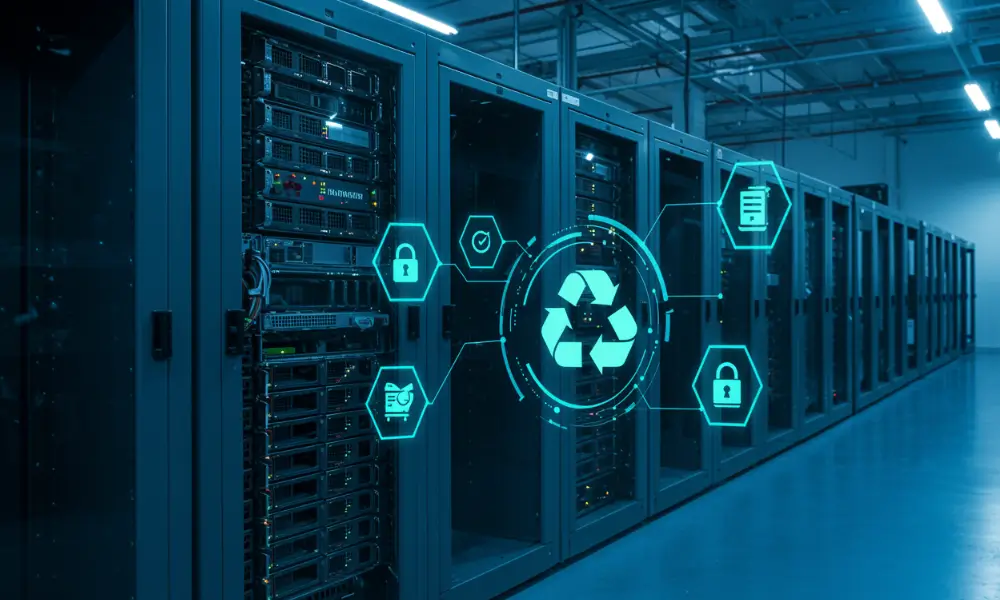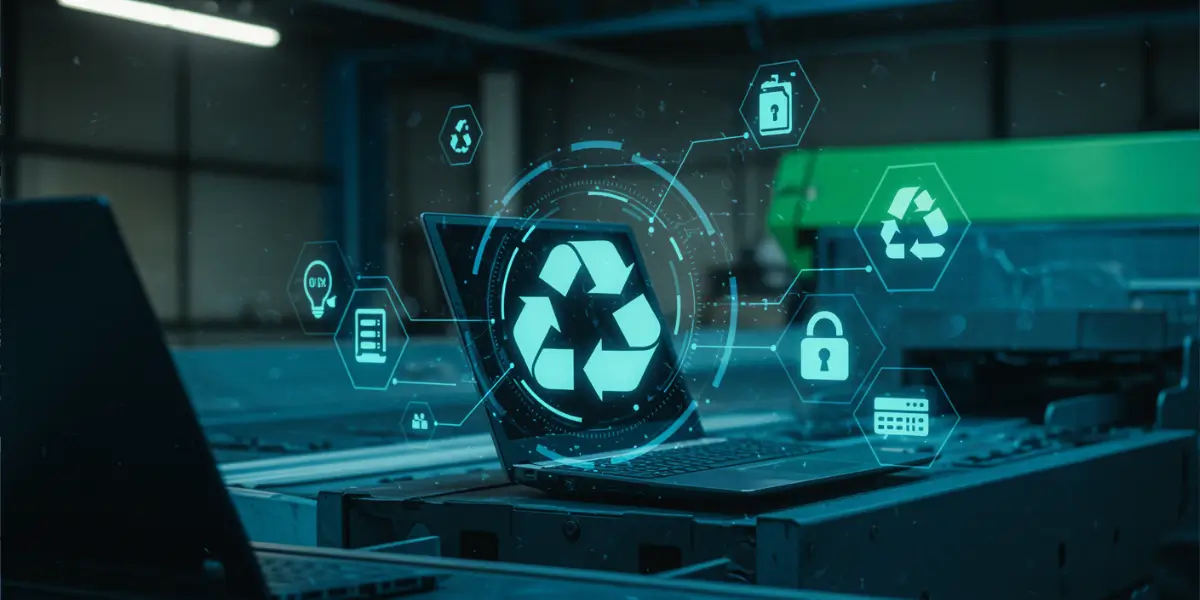In an age defined by rapid technological change, the sheer volume of retired laptops, servers, and networking gear is staggering. Yet as companies chase digital transformation, they often overlook a crucial element: It’s what happens at end-of-life that truly matters.
A strategic practice ensuring organizations handle obsolete tech in a way that is secure, compliant, and aligned with long-term environmental goals.
By integrating ITAD into corporate sustainability initiatives, businesses reduce e‑waste, strengthen data protection, bolster brand reputation, and unlock latent value from their hardware.

Integrating ITAD into Sustainable IT Solutions
At the heart of truly sustainable IT solutions lies the philosophy of the circular economy, which aims to extend the useful life of devices, recover valuable resources, and minimize waste.
Proper ITAD (IT Asset Disposition) plays a critical role in this model. Instead of allowing decommissioned hardware to accumulate in storage or be sent to landfills, it undergoes structured processes where materials such as metals and plastics are reclaimed, and functional equipment is refurbished or remarketed.
This approach conserves raw materials, reduces energy consumption, and significantly lowers an organization’s carbon footprint. Strategic ITAD enables businesses to minimize waste while maximizing residual value, turning what would otherwise be discarded into assets supporting environmental and financial goals.
By integrating ITAD into IT lifecycle planning, companies can transform isolated disposal events into consistent and sustainable resource streams.
The Role of Environmentally Friendly ITAD in Cutting E-Waste
A truly environmentally friendly ITAD program goes beyond basic compliance, prioritizing sustainability and responsible resource management at every stage. It involves working with certified recyclers, following zero-landfill policies, and safely handling hazardous materials such as mercury and lead.
Responsible ITAD contributes directly to reducing electronic waste and promoting a more sustainable future by ensuring that outdated equipment is processed with environmental integrity.
Conversely, improper disposal can lead to serious consequences, such as soil and water contamination, the loss of valuable recyclable materials, and broader negative impacts on ecosystems and communities. These are not abstract risks, but real-world outcomes that responsible ITAD practices are specifically designed to prevent.
From dismantling and sorting materials to reclaiming precious metals and reusable components, environmentally conscious ITAD ensures that every piece of hardware has the opportunity for a second, more sustainable life.
Ensuring Data Security Through Data Destruction Best Practices
Of course, ITAD isn’t solely about environmental responsibility; it’s also a critical component of cybersecurity and regulatory compliance. Organizations regularly decommission devices that contain sensitive data, including customer information, financial records, and proprietary business assets.
A single improperly handled disposal can lead to serious data breaches, costly penalties, and reputational harm.
This is why data destruction best practices are essential. Techniques such as degaussing, physical shredding, and software-based wiping, performed in accordance with recognized standards, ensure that data is permanently and irreversibly removed.
Proper documentation, including certificates of destruction, provides verifiable proof of compliance.
Beyond being a technical best practice, secure data destruction is a core requirement under data privacy regulations such as the General Data Protection Regulation (GDPR) and the Health Insurance Portability and Accountability Act (HIPAA). These frameworks mandate that organizations implement secure disposal procedures for all data-bearing assets.
Studies have shown that a significant portion of data breaches stem from inadequately sanitized retired equipment. Therefore, integrating robust, standards-driven destruction methods into ITAD processes is not optional; it’s a foundational step in safeguarding trust, meeting legal obligations, and supporting long-term data governance strategies.
Business and Environmental Benefits of Responsible ITAD
Efficient, responsible ITAD offers both financial and environmental returns. For businesses, the benefits are immediate; refurbished equipment can be resold, repurposed, or redeployed internally, creating opportunities for asset recovery and cost savings.
In addition, structured ITAD processes help avoid regulatory fines, reduce storage burdens, and mitigate the risks associated with data breaches. From an environmental perspective, the advantages are equally compelling. Proper e-waste handling conserves finite raw materials, prevents the release of hazardous substances, and supports broader corporate climate and sustainability goals.
ITAD minimizes environmental impact when implemented effectively while maximizing the value that can be recovered from retired technology.
In essence, each decommissioned device represents not just waste to be managed, but a strategic opportunity to reinforce sustainable practices, recover hidden value, and safeguard sensitive information.
Choosing the Right ITAD Partner for Sustainable Success
Selecting an ITAD partner requires careful consideration to ensure that your organization’s sustainability goals and data security needs are fully met. Here are some important factors to keep in mind when evaluating potential providers:
- First, look for partners who demonstrate strong project management capabilities and clear communication throughout the engagement. Effective ITAD programs involve multiple stakeholders, including on-site teams, remote support, and logistics personnel. Seamless coordination among all parties is critical to delivering timely, efficient, and error-free asset disposition.
- Secondly, consider the technical expertise and qualifications of the provider’s staff. Skilled and vetted engineers or technicians should be involved in every stage, from hardware decommissioning to data sanitization and equipment transportation. Many responsible providers conduct thorough background checks on their personnel to ensure compliance with legal requirements and to protect client privacy.
- Third, prioritize data security. The chosen ITAD partner must adhere to strict data destruction best practices, offering certified methods to irreversibly remove sensitive information. They should provide verifiable certificates of destruction as proof of compliance with applicable data protection laws and industry standards.
- Fourth, environmental responsibility is essential. Your ITAD provider should deliver cost-effective and environmentally friendly ITAD solutions that comply with local and international regulations. This includes minimizing landfill waste, responsibly recycling materials, and transparently documenting the chain of custody for retired assets.
Comprehensive logistics and storage solutions contribute significantly to a smooth ITAD process. Reliable packaging, secure transportation between sites and warehouses, and proper equipment storage are key components in preventing damage or loss during the disposition process.

Integrating ITAD into Sustainable IT Solutions
Partner with IP Global for end-to-end IT Asset Disposition (ITAD) solutions that prioritize data security, environmental responsibility, and regulatory compliance.
Also, if you’re upgrading your hardware, optimizing your IT infrastructure services in the USA, or conducting a detailed wireless network analysis in the USA, our expert team ensures seamless execution with minimal disruption.
Let us help you recover value, protect your data, and support your sustainability goals in one streamlined process.
Contact us today to future-proof your IT lifecycle.
Conclusion:
IT Asset Disposition is far more than a technical routine. It combines sustainable IT solutions, environmentally friendly ITAD, and strict data security via data destruction best practices.
Properly implemented, it slashes e‑waste, safeguards sensitive information, recovers value, and aligns companies with global sustainability and regulatory goals. As technology cycles accelerate and ESG commitments intensify, ITAD should be viewed not as an afterthought, but as a strategic imperative.
For organizations devoted to digital progress, environmental stewardship, and stakeholder trust, ITAD is important and indispensable.
By combining sustainable IT strategies, best-practice data destruction, and eco-conscious disposal, companies can transform retiring devices from liabilities into assets, protecting people, profits, and the planet at the same time.



